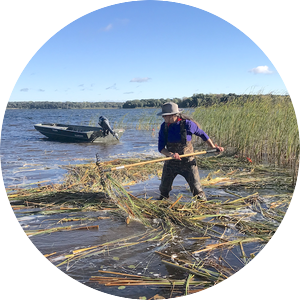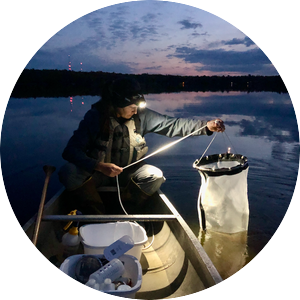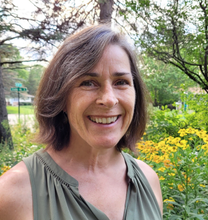Starry Trek results
Starry Trek is a statewide event focused on searching for one of Minnesota's aquatic invasive species, starry stonewort. This year’s Starry Trek took place on August 20th, with 233 volunteers searching 248 water bodies in Minnesota! No new starry stonewort discoveries were made. Shortly after Starry Trek, MN DNR did make an announcement of the discovery of starry stonewort in Lake Bemidji. This lake was not among those monitored during Starry Trek. Read more.
MAISRC hosted the annual Aquatic Invasive Species Research and Management Showcase on September 21st. MAISRC fellows presented their research findings and management updates to over 200 online attendees. Presentations were recorded, with Showcase attendees receiving exclusive access to the videos before they are shared with the general public. You can watch a sneak peek of one such presentation: “Refining copper-based treatment to suppress zebra mussel populations”, presented by Diane Waller, Angelique Dahlberg, and Matthew Barbour. Stay tuned for the public release of all presentation recordings, coming in December.
MAISRC Researcher Julia Bohnen Receives Carol Mortensen Award
The Minnesota Invasive Species Advisory Council (MISAC) presented MAISRC researcher Julia Bohnen with this award in recognition of her statewide leadership on non-native Phragmites management during the Upper Midwest Invasive Species Conference on October 25th. This award honors the memory of Carol Mortensen, who represented the Leech Lake Band of Ojibwe on the MISAC.
Bohnen has been instrumental in identifying and mapping non-native Phragmites, developing and implementing a state-wide management plan, and working with wastewater treatment facilities to transition away from using non-native Phragmites in their reed beds.
“Julia has advanced our state’s capacity to mitigate the impacts of invasive species and aid the recovery of affected ecosystems, with particularly significant contributions to Minnesota’s irreplaceable wetlands. We would not be where we are today in our capacity for coordinated, cross-jurisdictional Phragmites response if not for her outstanding contributions.” - Nominator
Research Outreach Update: Notes from the field, Fall 2022: Meg Duhr

Getting out into the field is always fun; who doesn’t need a break from emails and zoom meetings these days? Not only does spending time on our state’s beautiful lakes help remind me why we must stay in the fight against AIS, but working in the field with researchers and managers is also a necessary part of my outreach work. Understanding the reality of managing and monitoring invasive species helps make MAISRC outreach efforts more relevant and effective.
This September I was able to support a small-scale hybrid cattail removal effort out at Big Marine Lake, as part of MAISRC’s project, Enhancing Habitat and Diversity in Cattail-Dominated Shorelines. Working with managers from Washington County Parks and MAISRC grad fellow Brendan Nee, we spent about three hours in the water cutting, piling, and moving the cattail to shore. While this was a small area (10 x 40 meters) and a follow up treatment to last year’s mechanical removal work, I was still highly encouraged by how quickly we made a big difference in this area. We completed all the work using commonly available garden tools: grass shears, loppers, and a gas-powered trimmer with circular saw blade for cutting cattail below the surface of the water and on dry land; a garden rake for collecting and piling all the cut cattail; and a low, flat boat for transporting the material to the disposal area. Experiencing how simple and safe this process can be gives me a lot of hope for the potential of volunteer groups, lakeshore residents, and lake associations to maintain their own invasive cattail removal sites in the future. If our research indicates that small scale removals like this have a positive impact on restoring fish and native plant habitat, these methods could be a great new tool in our lake restoration toolbox.

Later in the fall, my wife and I spent an evening in a canoe conducting spiny water flea surveillance in Lake County. I wanted to see for myself if the protocol we developed for MAISRC’s new pilot program for volunteer spiny water surveillance could be safely and effectively implemented in a canoe. Fortunately, we were blessed with glass-calm waters and I’m happy to report that this method can easily be done in a canoe if conditions are right. I’m also happy to report that we did not find any spiny water fleas, but instead enjoyed seeing all the other interesting zooplankton that this lake supports: daphnia species, Chaoborus, and even a Leptodora, a nearly transparent, but beautiful little creature. Spiny surveillance can be a lot of fun and will give you a whole new appreciation for all the tiny life forms that are part of a lake ecosystem. Be sure to check out our page about the spiny surveillance program if you are interested in participating next year!
Partner Organization: Call for Input on Invasive Species
The Minnesota Department of Natural Resources is accepting public comment through December 9, 2022, on its proposal to classify 13 species or species groups as high-risk invasive aquatic plants, fish, and/or invertebrates as prohibited invasive species.
Visit the Invasive Species Program Rule-making webpage to view more information, detailed classification summaries for the species and frequently asked questions webpages for the species.
Please submit your comments to [email protected]. All information you submit in a public comment during formal rule-making proceedings is public data, including your name and contact information. The DNR invasive species rule-making website will be updated with final decisions about the proposed rules.
Staff Highlight: Alex Bajcz
Alex Bajcz is the new Quantitative Ecologist for MAISRC. He provides statistical, methodological, and computational support and guidance to MAISRC-funded research teams, especially the graduate students and post-docs on those teams. Alex is also busy collecting, wrangling, processing, archiving, improving, and analyzing data relevant to Aquatic Invasive Species (AIS) science in Minnesota and making these data and insights gleaned from available to research teams, stakeholders, and the public through platforms like AIS Explorer.
As part of his work with MAISRC, Alex has created a blog for supporting researchers with all things data. Check it out!
In the News
8/24/22: New Sequencing Method Tackles Environmental DNA Contamination for Cell-Free DNA Samples
8/24/22: Researcher says investment worthwhile to slow zebra mussels
9/2/22: Scientists try to get a handle on invasive carp at St. Paul's Como Lake
10/4/22: Study: Why are Lake Superior’s quiet winters so important?
10/24/22: Scum on your boat? Permit needed to let zebra mussels hitchhike to storage

